

12 Good Resources for Teaching Digital Citizenship - A PDF Handout. Why is Good Instructional Design More Important than Ever in the Modern World? Although instructional design as a discipline has been around for decades (and probably was at its height in the 1970’s and 1980’s as a profession, its application and use has diminished in the age of easy to use software and access to and use of Internet.
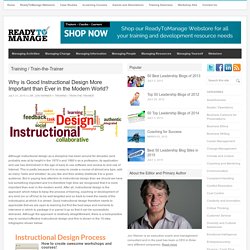
This is partly because it is so easy to create a course of almost any type, add as many “bells and whistles” as you like and then widely distribute it to a given audience. But in paying less attention to instructional design than we should we have lost something important and it is therefore high time we recognized that it is more important than ever in the modern world. After all, instructional design is the approach which helps to keep the process of training, coaching or development of any kind (on or off line) to be well-targeted and on track to meet the needs of the individual(s) at which it is aimed. Related Resources. 5 Highly Effective Teaching Practices. Dylan Wiliam.
Maori & Pacifica. 10 Surprising Facts about Finland’s Education System. Finland has consistently scored among the highest nations in the Programme for International Student Assessment (PISA), a standardized test given every three years by the Organization for Economic Co-operation and Development that measures student achievement across the globe.

Another remarkable fact about Finland’s education system is that students are only required to take one test during their entire time as students. Finland’s academic success has drawn a great amount of attention, leaving many countries wondering if it’s the Nordic country’s teaching methods or if there’s magic water in their fjord.
Here are 10 things that set Finland apart from the rest of the world in education. 1. School Starts Later Children in Finland don’t begin school until age seven. 2. Sutton Trust - What makes great teaching? Summary This report reviews over 200 pieces of research to identify the elements of teaching with the strongest evidence of improving attainment.
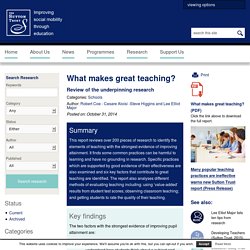
It finds some common practices can be harmful to learning and have no grounding in research. Specific practices which are supported by good evidence of their effectiveness are also examined and six key factors that contribute to great teaching are identified. The report also analyses different methods of evaluating teaching including: using ‘value-added’ results from student test scores; observing classroom teaching; and getting students to rate the quality of their teaching. Key findings The two factors with the strongest evidence of improving pupil attainment are: teachers’ content knowledge, including their ability to understand how students think about a subject and identify common misconceptionsquality of instruction, which includes using strategies like effective questioning and the use of assessment.
Teaching Creativity – The Case for Mind Mapping. If thinking is about making connections between pieces of information, then creative thinking is making the connections that no one else has seen.
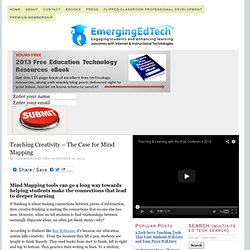
However, when we tell students to find relationships between seemingly disparate ideas, we often get blank stares—why? According to thinkers like Ken Robinson, it’s because our education system kills creativity. From the moment they lift a pen, students are taught to think linearly. They read books from start to finish, left to right and top to bottom.
They practice their writing in lines. 31 eLearning Lessons from 2014 to Guide You in 2015. The year is about to end, and people around seem to have gone into a nostalgic mood.

Websites are fondly remembering what took place in the year gone by—trends that ruled the ramp, blockbusters that broke box-office records, and men, women, and events that made an impact. Year-end seems to be the ideal time for reflection and recapitulation. So why don't we? As eLearning professionals, we learned many important lessons in 2014. SeptemberBriefings_14_A4.pdf. A culture of trust enhances performance. The following article is adapted from extracts of the Literature review: a culture of trust enhances performance, prepared for the Australian Institute for Teaching and School Leadership (AITSL) by Dr Jessica Harris, Professor Brian Caldwell and Ms Fiona Longmuir. © Australian Institute for Teaching and School Leadership, used with permission.

Creating a safe space within schools is key to developing innovative, creative and collaborative practices that directly enhance student achievements.
Feedback. Growth Mindset. Interesting Poster Featuring The 7 Tenets of Creative Thinking. Learning to Learn. Professional Learning Animation. Engage Your Students With These Open Educational Resources. SOLO Apps. Search results for: '741' The IB Learner Profile: Risk-taking -v- Courage. I was looking for a couple of documents on the IB Online Curriculum Centre today as I needed to download them to take on my Workshop Leaders Training next week, when I stumbled across a recent document by George Walker where he discusses whether the IB is too closely associated with Western values.

As it happens I had been having the same conversation with a friend on Sunday, a teacher who used to teach MYP and DP but who has now left international education. Www.robsartstudio.com/uploads/7/9/6/0/7960218/quickstartguide.pdf. BES (Iterative Best Evidence Synthesis) Programme. Instructional Design Models and Theories: Gestalt Theory. The Art of Failing in School and Succeeding in Life. A young man was restless in his studies.

Little Bull Music Blog: Light up the room with Higher Order Thinking. Light up the room with Higher Order Thinking A few of my colleagues and I have been discussing questioning and how we can form better questions for our classrooms.
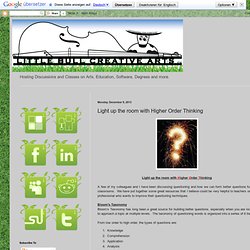
We have put together some great resources that I believe could be very helpful to teachers or any professional who wants to improve their questioning techniques.
Education Needs a Digital-Age Upgrade. Brisbane Girls Grammar School. Mr Trent Driver, Dean of Academic Development Over the past few weeks, I think I have felt a bit like my GP might feel, sitting in his office with a full list of people awaiting his attention.
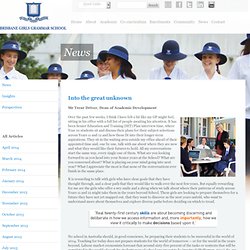
It has been Senior Education and Training (SET) Plan interview time, where Year 10 students sit and discuss their plans for their subject selections across Years 11 and 12 and how those fit into their longer-term aspirations. What Sir Ken Got Wrong. “We are educating people out of their creativity” Sir Ken Robinson Sir Ken Robinson’s ideas on education are not only impractical; they are undesirable.
Ten of the best virtual field trips. 70 Tools And 4 Reasons To Make Your Own Infographics. Infographics are everywhere. Some love them. Some hate them. But however you feel, it’s fun to learn a little bit in a short period of time. Most are made so you can quickly grasp the key concepts behind them. The Teacher's Guide To Wikipedia In The Classroom.
Contemplative Pedagogy. “Opening the contemplative mind in schools is not a religious issue but a practical epistemic question… Inviting contemplative study simply includes the natural human capacity for knowing through silence, pondering deeply, beholding, witnessing the contents of consciousness and so forth.” ~ Tobin Hart, Opening the Contemplative Mind in the Classroom, Journal of Transformative Education Vol. 2 No. 1, January 2004 The ancient practice of contemplation is being explored by many institutions of higher education as a new means of enhancing liberal education. Research demonstrates that “contemplative pedagogy”-the integration of meditative practices into higher education-facilitates the achievement of traditional educational goals such as improved cognitive and academic performance. Studies also show that it fosters the development of the whole person, increasing capacities such as creativity, empathy, compassion, interpersonal skills and self-awareness.
Teaching as Inquiry. BES Exemplars. The BES exemplars focus on how to make a much bigger difference in education. The BES exemplars highlight the potential for disciplined innovation to accelerate systemic improvement in areas of need in schooling. Five new BES exemplars have been prepared in partnership with teachers, researchers and professionals who have led outstanding teaching in New Zealand. Each exemplar has been selected because it illuminates highly effective teaching approaches that accelerate progress for diverse (all) learners in areas where improvement is needed.
They exemplify the eleven dimensions of quality teaching using examples that come from across the curriculum and are relevant to primary, intermediate, and secondary levels of schooling. 25 Killer Websites that Make You Cleverer.